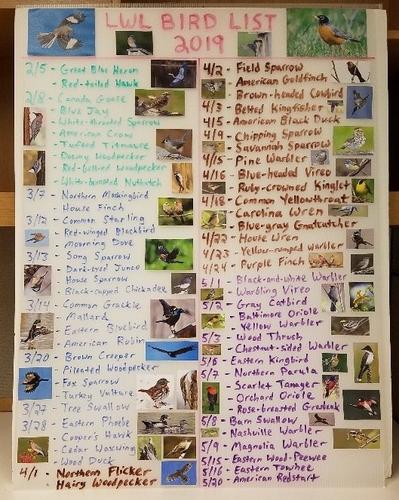By Scott Poglitsch
Since 2016, Catalog Assistant Scott Poglitsch has kept a yearly list of birds seen from the fourteen-acre library campus and has led informal bird walks for interested fellows and staff. The diverse habitats on the property – including manicured lawns, a weedy field, shrubby undergrowth, and a forested slope leading to the Pequabuck River – provide abundant foraging and nesting opportunities for a variety of species. The tally for 2019 (as of late-May) is up to sixty-nine, with a cumulative count of eighty different species identified over the past few years. An effort this spring to photograph the library’s feathered visitors has proven fruitful, and these pictures will help illustrate the birds’ appearances and habits during the following overview of bird life at The Lewis Walpole Library.
The birds of the ‘burbs
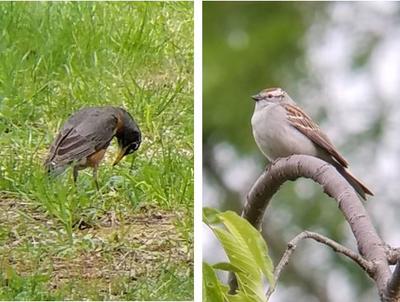 You need not venture far from the library buildings to experience the sights and sounds of avian activity in Farmington. American Robins (pictured, left) are a common sight on the grass surrounding the parking lot, and the thawing ground in early spring attracts them in droves to hunt insects and worms on the vast lawn behind the New Library. The weeping cherry trees just beyond the parking area provide perches from which Northern Mockingbirds, House Finches, and Chipping Sparrows (pictured, right) sing their enthusiastic songs. And every summer the serviceberry trees beside the Reading Room incite a feeding frenzy among the Cedar Waxwings, which flit around excitedly and swallow the ripe fruits whole.
You need not venture far from the library buildings to experience the sights and sounds of avian activity in Farmington. American Robins (pictured, left) are a common sight on the grass surrounding the parking lot, and the thawing ground in early spring attracts them in droves to hunt insects and worms on the vast lawn behind the New Library. The weeping cherry trees just beyond the parking area provide perches from which Northern Mockingbirds, House Finches, and Chipping Sparrows (pictured, right) sing their enthusiastic songs. And every summer the serviceberry trees beside the Reading Room incite a feeding frenzy among the Cedar Waxwings, which flit around excitedly and swallow the ripe fruits whole.
Shy dwellers of the thickets
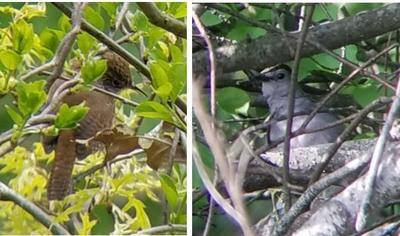 A short walk back from the parking lot brings you to the shrubby margins of the field and woods, where you’ll find several birds more often heard than seen. Unless you recognize their bubbly song or notice the frenetic movement of a House Wren (pictured, right) in a tangle of sticks, you might mistake one for a dry leaf. Similarly, the Gray Catbird (pictured, right) blends nearly perfectly into a background of beech tree branches, requiring a sharp eye to pinpoint the source of the repetitive songs and mewing calls emanating from the undergrowth.
A short walk back from the parking lot brings you to the shrubby margins of the field and woods, where you’ll find several birds more often heard than seen. Unless you recognize their bubbly song or notice the frenetic movement of a House Wren (pictured, right) in a tangle of sticks, you might mistake one for a dry leaf. Similarly, the Gray Catbird (pictured, right) blends nearly perfectly into a background of beech tree branches, requiring a sharp eye to pinpoint the source of the repetitive songs and mewing calls emanating from the undergrowth.
The acrobatic King of the field
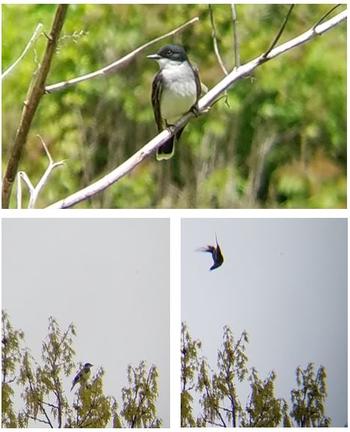 The abundance of insects in the back field may not be ideal for the humans who venture out there, but it’s a perfect situation for the insectivorous birds that stop by. Walk back there in late February and you’ll no doubt be greeted by Eastern Bluebirds, which are among the earliest arrivals in spring. The male, a brilliant royal blue, and the grayish-blue female typically hunt together, the pair descending to the ground from low branches on the side of the field to pick insects or larvae out of the grass. Return in mid-April and you’ll notice the addition of an airborne squadron of Tree Swallows, with up to a dozen individuals zooming around like little airplanes, scooping up insects in mid-air. And for a couple weeks in May, the Eastern Kingbirds reign supreme, boldly perching in the center of the field (pictured, top) and occasionally darting out to snatch a passing insect. When inspired to sing, these flycatchers become even more conspicuous, ascending to the treetops (pictured, bottom left) and pausing their buzzy song only briefly while executing an impressive flip to nab an insect (pictured, bottom right).
The abundance of insects in the back field may not be ideal for the humans who venture out there, but it’s a perfect situation for the insectivorous birds that stop by. Walk back there in late February and you’ll no doubt be greeted by Eastern Bluebirds, which are among the earliest arrivals in spring. The male, a brilliant royal blue, and the grayish-blue female typically hunt together, the pair descending to the ground from low branches on the side of the field to pick insects or larvae out of the grass. Return in mid-April and you’ll notice the addition of an airborne squadron of Tree Swallows, with up to a dozen individuals zooming around like little airplanes, scooping up insects in mid-air. And for a couple weeks in May, the Eastern Kingbirds reign supreme, boldly perching in the center of the field (pictured, top) and occasionally darting out to snatch a passing insect. When inspired to sing, these flycatchers become even more conspicuous, ascending to the treetops (pictured, bottom left) and pausing their buzzy song only briefly while executing an impressive flip to nab an insect (pictured, bottom right).
Warblers high and low
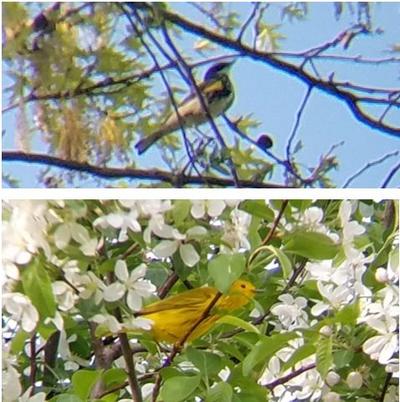 Warmer temperatures and developing leaves bring with them an influx of warblers to the property each spring, many of which are long-distance migrants that stop by to forage before continuing their journey north. Look to the tops of the mature oaks on the property, and you might see a flash of yellow or black as these small birds dart around and glean insects off of leaves, twigs, and flowers. Only through binoculars can the vibrant markings of the male Yellow-rumped Warbler (pictured, above), Magnolia Warbler, and Northern Parula be fully appreciated, and an attentive ear reveals the beautiful variety of sweet, soft and buzzy songs they produce. You’ll sometimes see a Yellow Warbler (pictured, below) foraging down low if a flowering tree entices them, and species such as Palm Warblers are even seen foraging on the ground. Warbler diversity is enhanced by the proximity of the river and its forested slope, which provide habitat for the wetland-inhabiting Common Yellowthroat and the forest-dwelling Black-and-white Warbler, among others.
Warmer temperatures and developing leaves bring with them an influx of warblers to the property each spring, many of which are long-distance migrants that stop by to forage before continuing their journey north. Look to the tops of the mature oaks on the property, and you might see a flash of yellow or black as these small birds dart around and glean insects off of leaves, twigs, and flowers. Only through binoculars can the vibrant markings of the male Yellow-rumped Warbler (pictured, above), Magnolia Warbler, and Northern Parula be fully appreciated, and an attentive ear reveals the beautiful variety of sweet, soft and buzzy songs they produce. You’ll sometimes see a Yellow Warbler (pictured, below) foraging down low if a flowering tree entices them, and species such as Palm Warblers are even seen foraging on the ground. Warbler diversity is enhanced by the proximity of the river and its forested slope, which provide habitat for the wetland-inhabiting Common Yellowthroat and the forest-dwelling Black-and-white Warbler, among others.
Orioles in two hues
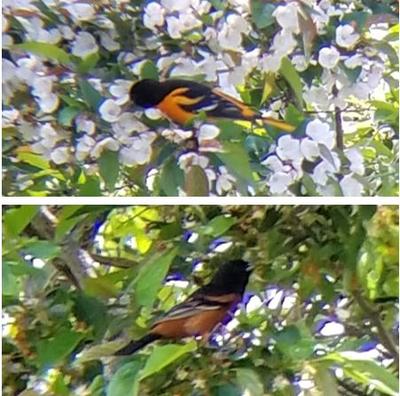 The beginning of May is an exciting time overall, when a large number of migratory birds return to the area. But the day the orioles arrive is marked by particular hubbub, with the loud, clear songs of the males resonating throughout the property. The mating competition has even spilled over into the parking area in recent years, with several males seen chasing one another from tree to tree, aggressively chattering and oblivious to the spectators below. Most people think of the bright orange Baltimore Oriole (pictured, above) when they hear the word “oriole”, but you’ll also find a second species on the library campus that is brick-red in color and sings a wholly different song. This Orchard Oriole (pictured, below), like its more brightly-colored kin, enthusiastically feeds on nectar from the flowering trees at the edge of the field. Both species ultimately nest closer to water, but they are a conspicuous presence at the library for several weeks beforehand.
The beginning of May is an exciting time overall, when a large number of migratory birds return to the area. But the day the orioles arrive is marked by particular hubbub, with the loud, clear songs of the males resonating throughout the property. The mating competition has even spilled over into the parking area in recent years, with several males seen chasing one another from tree to tree, aggressively chattering and oblivious to the spectators below. Most people think of the bright orange Baltimore Oriole (pictured, above) when they hear the word “oriole”, but you’ll also find a second species on the library campus that is brick-red in color and sings a wholly different song. This Orchard Oriole (pictured, below), like its more brightly-colored kin, enthusiastically feeds on nectar from the flowering trees at the edge of the field. Both species ultimately nest closer to water, but they are a conspicuous presence at the library for several weeks beforehand.
A splash of color in the woods
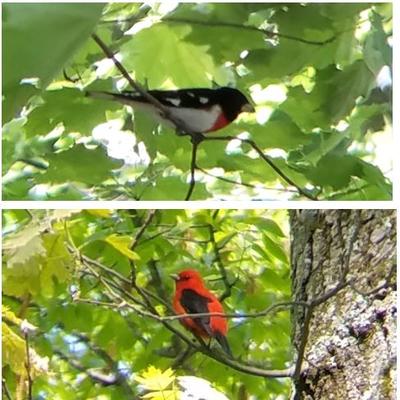 The late spring eruption of leaves makes forest-dwelling birds decidedly more difficult to see, but nature assists by making the males of several species spectacularly colorful. If you walk along the edge of the woods at the back of the field and peer down the slope towards the river, you’ll encounter a wall of dense foliage at many times during the year. Some familiarity with bird song might allow you to recognize the flute-like notes of a Wood Thrush or the rambling tune of a Warbling Vireo coming from the shadows, but you’d be hard-pressed to actually lay eyes on one of these rather drab birds. Suddenly, your gaze is drawn to a patch of red among the trees, perhaps the rose red bib of a Rose-breasted Grosbeak (pictured, above), a species that visits the property every year. Or maybe it’s the red-and-black color scheme of a Scarlet Tanager (pictured, below), a bird first spotted at the library this spring. The males of both species sing a musical, Robin-like song, proving that they have more to offer than just flashy appearances.
The late spring eruption of leaves makes forest-dwelling birds decidedly more difficult to see, but nature assists by making the males of several species spectacularly colorful. If you walk along the edge of the woods at the back of the field and peer down the slope towards the river, you’ll encounter a wall of dense foliage at many times during the year. Some familiarity with bird song might allow you to recognize the flute-like notes of a Wood Thrush or the rambling tune of a Warbling Vireo coming from the shadows, but you’d be hard-pressed to actually lay eyes on one of these rather drab birds. Suddenly, your gaze is drawn to a patch of red among the trees, perhaps the rose red bib of a Rose-breasted Grosbeak (pictured, above), a species that visits the property every year. Or maybe it’s the red-and-black color scheme of a Scarlet Tanager (pictured, below), a bird first spotted at the library this spring. The males of both species sing a musical, Robin-like song, proving that they have more to offer than just flashy appearances.
Summer of the Swallow
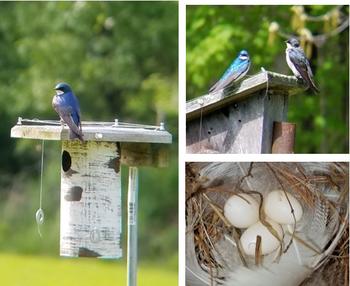 As spring turns to summer, many bird species vacate the library property for distant breeding grounds or leave to nest in wetter or more forested areas nearby. But a walk in the back field in June reveals that the Tree Swallows are here to stay, content to nest in the provided boxes (pictured, left and top right) and satisfied with the abundance of insect food with which to feed their nestlings. You might notice they are a little more aggressive now, dive-bombing and bill-clacking at any human intruder who ventures too close to an active nest. This protective parental instinct keeps the eggs safe in the feather-lined nest (pictured, bottom right), ensuring that future generations of swallows will return to the field to provide their valuable insect-control services.
As spring turns to summer, many bird species vacate the library property for distant breeding grounds or leave to nest in wetter or more forested areas nearby. But a walk in the back field in June reveals that the Tree Swallows are here to stay, content to nest in the provided boxes (pictured, left and top right) and satisfied with the abundance of insect food with which to feed their nestlings. You might notice they are a little more aggressive now, dive-bombing and bill-clacking at any human intruder who ventures too close to an active nest. This protective parental instinct keeps the eggs safe in the feather-lined nest (pictured, bottom right), ensuring that future generations of swallows will return to the field to provide their valuable insect-control services.
